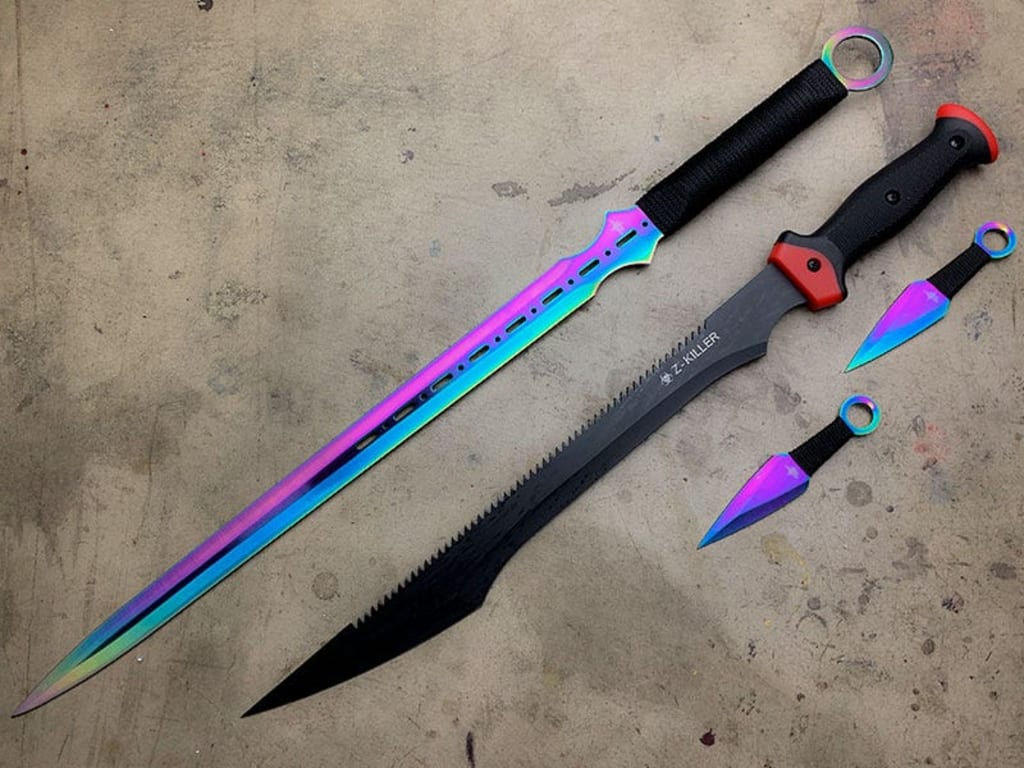The Enigmatic World of Ninja Swords: Blades of Stealth and Precision!
Ninja Swords

Ninja swords, also known as shinobigatana or ninjatō, have a fascinating history that is deeply rooted in the ninja, the clandestine agents of feudal Japan. These swords, which were made for stealth, agility, and surprise attacks, were usually more functional and utilitarian than the more elaborate katana used by samurai.
Compared to traditional katanas, these swords frequently had straight blades that allowed for more maneuverability in confined spaces. The ninja's need for efficiency and practicality in their covert operations was reflected in the simplicity of the sword's design. Their swords were instruments of guerilla warfare, sabotage, and espionage; they embodied the spirit of the ninja's cunning and stealthy style of fighting.
Ninja Swords: Tools of Stealth and Precision
Ninja swords, also known as ninjatō, are iconic weapons that represent the dexterity and stealth of the ninja, Japan's clandestine agents. Ninja swords, in contrast to the more ornate katana of samurai, were made with efficiency and practicality in mind. These swords, which usually had a single-edged, straight blade, made it possible for the ninja to move quickly and precisely, which was necessary for their close-quarters fighting and guerilla tactics.
The handguard, or tsuba, was frequently square to help with defense and utility, and the scabbard could hold extra weapons or poisons to increase the ninja's adaptability for different types of missions. Ninja swords are valuable items for martial artists, collectors, and admirers of Japanese culture because of their captivating historical significance and distinctive design.
Distinctive Design Elements in Ninja Swords
Ninja swords are distinguished from other traditional Japanese weapons by their distinctive design, which reflects the particular needs of their clandestine wielders. The blades of ninja swords, also known as ninjatō, are usually single-edged and straight, unlike the katanas used by samurai. This ninja's stealthy and agile fighting style relied heavily on their ability to thrust quickly and precisely, which was made possible by their straight design.
Because the blades were typically shorter—between 24 and 30 inches—they could be more easily maneuvered in tight areas, like alleyways and indoor spaces. The handguard, also known as the tsuba, was typically square or rectangular and provided more than just hand protection; it could be used as a tool in different survival scenarios or to climb walls. Simple materials like leather or cloth were wrapped around the sword's handle, or tsuka, to provide a secure grip even in slick or fast-moving situations.
Furthermore, the scabbard, or saya, was a multipurpose item that occasionally had secret compartments for holding poisons, blinding powder, or small tools, improving the ninja's versatility. Together, these design elements gave the ninja sword a multipurpose and useful instrument for surprise attacks, fast escapes, and espionage, reflecting the resourcefulness and inventiveness of the ninja.
Modern Interpretations and Uses of Ninjato
Ninja swords have changed from their historical origins to become iconic representations of popular culture, cultural heritage, and martial arts discipline in the modern era. These swords are meticulously crafted to reflect the traditional design in contemporary replicas, which often incorporate modern materials and manufacturing techniques to improve performance and durability. These swords are used by martial artists who train in traditional ninja methods and ideologies, such as ninjutsu, which emphasize stealth, agility, and precision.
In addition to being useful training aids, these swords provide physical links to the ninja's rich past and enigmatic persona. Ninja swords have made their way outside of the dojo and into the collections of history buffs and admirers of Japanese culture, where they are prized as ornamental pieces and reminders of an intriguing past. Their status in popular culture has been further solidified by their appearance in anime, video games, and films, where they are frequently portrayed as the classic weapon of the mysterious and shadowy ninja.
Ninja swords are becoming increasingly popular among collectors and cosplayers due to their widespread recognition, which has sparked interest worldwide. Modern interpretations of ninja swords continue to captivate imaginations, bridging the gap between historical tradition and contemporary fascination, whether they are used for training, display, or as props in media.
Selecting the Right Ninja Sword
Selecting the ideal ninjato sword requires taking into account several aspects, such as the weapon's intended use, construction quality, and authenticity. A balanced sword composed of sturdy materials is necessary for martial arts practitioners to train and perform effectively. Blades made of high-carbon steel are stronger and sharper than those made of stainless steel, though stainless steel can be used aesthetically.
Because the handle and scabbard add to the sword's overall functionality and aesthetic appeal, it is important to take their craftsmanship into account. The sword maker's reputation and historical accuracy may be of utmost importance to collectors. Understanding the historical significance and useful design of a ninja sword is essential when choosing one for training, exhibition, or cultural preservation.
About the Creator
Mai Sophia
A Writer/blogger by day, a knife enthusiast and survivalist by night. I've reviewed a lot of products and have helped people make the right purchase
Enjoyed the story? Support the Creator.
Subscribe for free to receive all their stories in your feed. You could also pledge your support or give them a one-off tip, letting them know you appreciate their work.






Comments
There are no comments for this story
Be the first to respond and start the conversation.